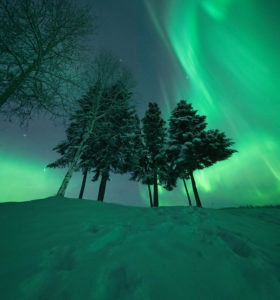“Flagstaff has massively limited its light footprint. If Fairbanks can move in that direction, we can make a significant impact.”
“We knew that Flagstaff had done something unusual, but in recent years we’ve actually been measuring it. We’ve surprised ourselves at how well we had done,” said Flagstaff Dark Skies Coalition President Chris Luginbuhl. “We compared measurements of the sky glow over Flagstaff with a city of a similar size and found that Flagstaff is more than 90% fainter, one-tenth as bright. That’s stunning! And that has really helped to underscore for us that we really have something that’s important, that we need to understand what it is that we did that has resulted in that success and find a way to convey it to others so that the rest of world also can take advantage of the ground-tested techniques that we have pioneered in Flagstaff.”
Coalition volunteers promote the beauty and also the many reasons why dark skies should be protected. Obvious reasons are for science and space exploration, but others include human health, ecological concerns, spiritual and cultural connections, aesthetics and energy conservation. And for communities in the far north, dark skies keep their views of the aurora borealis bright.
“It’s one of those things that you really have to see in person to really appreciate,” said Explore Fairbanks President and CEO Scott McCrea. “I’ve been here 35 years. There’s never the case of getting tired of seeing it – a band of green light and dramatic movements across the sky. I’m as amazed now as the first time I saw it. It’s a sight to behold. It’s a big part of what defines us as a destination.”
During the pandemic, Alaska’s tourism and government leaders say the aurora borealis over Fairbanks has become even more attractive to Americans who haven’t been able to travel to Iceland or Finland for the Northern Lights experience. But also, there is a growing awareness that their night skies are not as dark as they remember.
Fairbanks North Star Borough Assemblyperson Aaron Lojewski suspects the use of LED lights has made the night sky brighter and the aurora borealis dimmer. “There are a lot of people noticing and grumbling, but nobody has done anything about it,” he said.
Lojewski grew up hiking around Flagstaff. His dad studied forestry at Northern Arizona University as a young man and enjoyed coming back to visit, bringing Aaron with him. “I could see the Milky Way just fine, which is pretty unusual for a city of that size. I know what can be done in terms of reducing sky glow. And Flagstaff has massively limited its light footprint. If Fairbanks can move in that direction, we can make a significant impact.”
When organizers began planning for January’s Annual Interior Tourism Conference in Fairbanks, Lojewski, McCrea and others wanted to bring in a dark skies consultant as a speaker. Coalition Executive Board Secretary and amateur astronomer Drew Carhart made the trip.
“It became really obvious that this was a new concept to almost all the people up there,” said Carhart. “There’s not a practical understanding of the dark skies, about what can be done, about what causes the issue. My goal was to start from scratch, to lay out the issues and why the community should be concerned, and to promote the idea that Flagstaff has solutions.”
“The information from Drew was well received,” said McCrea. “It’s not something people had given much thought to, but it’s been eye-opening and food for thought. That’s the main thing, that’s what we wanted, to get the conversation going. Now we have to make sure the conversation doesn’t get lost moving forward.”
“The borough is the largest government entity in the area geographically, but it actually controls very few streetlights. The majority are controlled by the Alaska Department of Transportation on big arterial streets and highways,” said Lojewski. “What we do control is we can help steer the conversation and form partnerships.”
Lojewksi says his hope is to get the city council, borough and state talking, using dark-skies friendly amber lighting solutions and adopting lighting standards, similar to Flagstaff’s. “Drew raised awareness. He took this great picture of China Hot Springs Resort, 20 miles out of town. The lights of the city are more evident from there, out under those dark skies.”
“The sky dome glow was quite notable. It was quite substantial,” said Carhart. “Flagstaff from that distance away you wouldn’t see light like that and yet Flagstaff is a much bigger place.”
Carhart gave four presentations and toured neighborhoods to assess the efficiency of different light fixtures. “As far as light pollution in Fairbanks, it’s notably higher than Flagstaff because they’ve done no lighting regulation or effort,” he said.
But Carhart adds that lighting is not being done well most anywhere in the United States. “It’s just not paid attention to or understood well enough,” he said. “In our work with the Coalition since really identifying what The Flagstaff Solution is, we’ve ended up putting at the top of the list that community involvement is the most important thing and that you’re not going to get far without it.” FBN
By Bonnie Stevens, FBN
Hear more from Flagstaff Dark Skies Coalition Executive Board Members Drew Carhart and Chris Luginbuhl on Zonie Living: Business, Adventure and Leadership. Find Zonie Living at starworldwidenetworks.com






